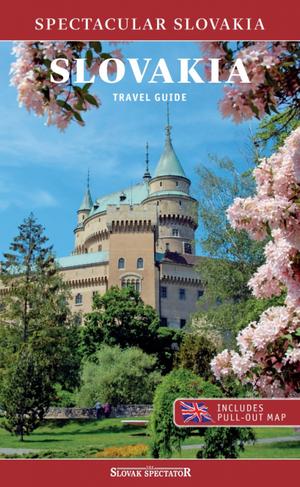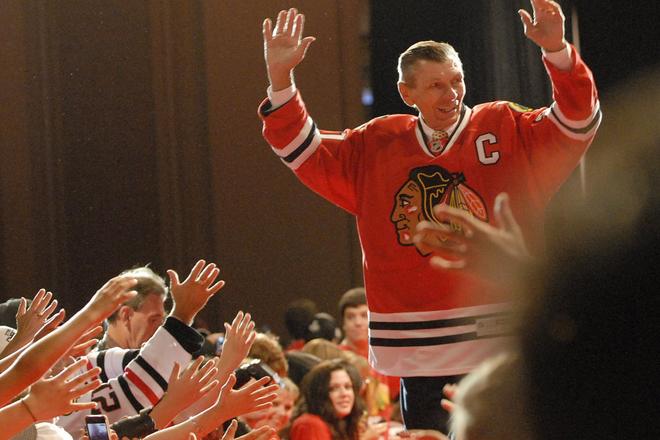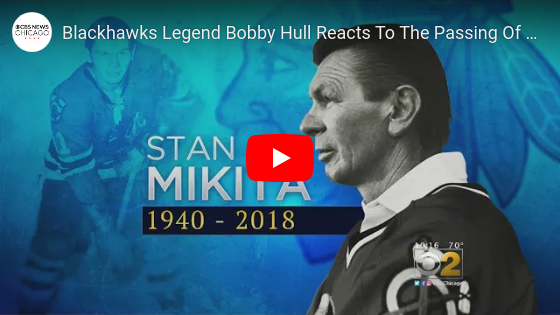You can read this exclusive content thanks to the FALATH & PARTNERS law firm, which assists American people with Slovak roots in obtaining Slovak citizenship and reconnecting them with the land of their ancestors.
When ice-hockey began, hockey sticks were straight. Then, as the tale goes, while practicing Stan Mikita accidentally wedged the blade of his stick in the crack of a door in the boards and bent it, but not entirely. Before he could change it, he received a pass and shot the puck, only to realise that the shot was much faster and harder.
From that point on, Mikita was among the top scorers in the NHL.
Although Mikita is usually credited as the inventor of the curved blade, he probably wasn't the first player to wield it. But he definitely was instrumental in spreading the practice to the point it has become a staple.
This is not the only thing Slovak native Stan Mikita achieved in his hockey career, far from it. Actually, it would take a while to mention them. For example, he was the first player of Slovak origin to win the Stanley Cup; he was the first player from Europe to score over 1,000 points; he is the only player to win the Art Ross Trophy for the most points in the regular season, the Hart Trophy for the most valuable player and the Lady Byng Trophy for sportsmanship in a single season - and Mikita actually achieved this two times in a row.
Finding courage
Stan Mikita was born as Stanislav Guoth in 1948 in a small village of Sokolče in the northern Slovakia, that was later flooded when the Liptovská Mara reservoir was built.
In 1948, he was adopted by his aunt and uncle Anna and Joe Mikita, who had emigrated to Canada and settled in the town of St. Catharines near Toronto, Ontario. They had no children of their own, but wanted one. When Stan's older brother was born, they sent the family a letter and suggested that if another child would be born, they would adopt them.
 A helping hand in the heart of Europe offers a travel guide of Slovakia. CLICK TO LEARN MORE. (source: Spectacular Slovakia)
A helping hand in the heart of Europe offers a travel guide of Slovakia. CLICK TO LEARN MORE. (source: Spectacular Slovakia)
"When my aunt and uncle took me to the station in Prague, I was wondering what Canada would be like. But when I saw the train ready to leave and the parents I was supposed to leave there, I started to cry. I was planning how to jump off the train and that I would return to them the whole time," Mikita recalled years later.
In his biography, he also admitted that was interested in his older brother's skates. One day he borrowed them without telling anybody. After falling several times, he returned them. But his brother noticed; since little Stan walked on stones with, the blades were blunt and forced Stan to admit to taking them and never to use them again.
However, once in Canada, he discovered ice-hockey while watching boys through a window. Even though at the time he didn't know any English at all, he quickly joined them. Puck, hockey stick, goal and foreigner were supposedly the first English words he learned. Then, spurred on by a friend, he joined the school hockey club and got his first real ice skates and later went on to spend three years in the local St. Catharines Teepees team.
Feared forward
A breakthrough moment came in October 1958. One evening, a phone rang. Harry Watson, the coach of the St. Catharines Teepees told Mikita to pack, take a midnight train to Chicago. He was going to play the next evening in the NHL, for the Chicago Blackhawks against the Montreal Canadiens. He played three matches in 1958-59, but the next was his first full season.
In his early NHL years, Mikita made a name for himself; he was among the most penalised players, almost always sitting in the penalty box. In the 1964/1965 season, he spent a total of 154 minutes in the penalty box. In an interesting turn of events, he managed to curb that to 58 in the following season, and even more to mere 12 in the next. Mikita said this was because of his daughter who asked why he was sitting so much while others played the game. He went on to win the Lady Byng Trophy for sportsmanship twice.
Together with legendary Bobby Hull, they became well-known and feared forwards. Their sticks with curved blades gave them an edge over opposing goalkeepers. In 1960s, Mikita led the league in scoring four times.
The curved blade was not the only piece of hockey equipment Mikita was a proponent of. He was also one of the first players to regularly wear a helmet. This came after a shot tore a part of his ear away - it was later stitched back.
When Mikita ended his career after the 1979-80 season - all for Chicago Blackhawks - he played in 1,394 matches, in which he scored 541 goals and had 926 assists, totalling in 1,467 points. At the time he ranked third in the most points scored after Gordie Howe and Phil Esposito, respectively (he currently ranks 17th). He was the first Blackhawks player to have his jersey number, 21, retired.
Three years later, he was inducted into the Hockey Hall of Fame. In 2002, he was also inducted into the Slovak Hockey Hall of Fame. In 2011, his statue was installed outside the United Center, the home of Chicago Blackhawks.
Remembering
Mikita visited Slovakia several times in his life after his leaving. The first time was in 1960. He came back seven years later to play several exhibition games for Slovak teams, most notably for the VSŽ Košice club for which he scored four goals against the Banská Bystrica hockey club.
Internationally, he also played several games for Canada, including one against Czechoslovakia in Prague.
In 2015, Mikita was diagnosed with Lewy body dementia, which eventually caused him to lose all memory of his life. He died on August 7, 2018.
"I, alongside all who played with him, knew him not only as a great player, but as an even better friend, teammate, husband, father and grandfather. I take comfort in knowing we will be forever together in front of the United Center, and I'm honored to now play a part in keeping his legacy alive," said former teammate Bobby Hull after Mikita passed, as quoted by CBS News.
Spectacular Slovakia travel guides
A helping hand in the heart of Europe thanks to our Slovakia travel guide with more than 1,000 photos and hundred of tourist spots.
Our detailed travel guide to the Tatras introduces you to the whole region around the Tatra mountains, including attractions on the Polish side.
Lost in Bratislava? It's impossible with our City Guide!
See some selected travel articles, podcasts, traveller infoas well as other guides dedicated to Nitra, Trenčín Region, Trnava Region and Žilina Region.


 Stan Mikita arriving at regular meeting with Chicago Blackhawks fans, July 26, 2013. (source: AP/TASR)
Stan Mikita arriving at regular meeting with Chicago Blackhawks fans, July 26, 2013. (source: AP/TASR)

 Terra Parna Winery (source: Courtesy of Trnava Región)
Terra Parna Winery (source: Courtesy of Trnava Región)